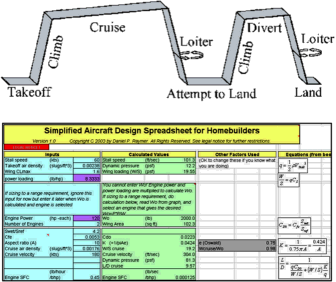The free programs below are now Windows executables, and much improved

Here are some free and useful programs for aircraft designers, rewritten and recompiled so that they will run on current versions of Windows. These use simple text-based inputs and outputs, and automatically write inputs and results to the Windows clipboard for use in other programs. Note that the source code listings below are for the classic Basic versions.
AC-SIZE calculates aircraft takeoff weight and fuel weight to perform an input mission, which can include cruising range, loiter time, climbs, takeoff, landing, and combat. Required inputs include aircraft drag coefficient, engine thrust, specific fuel consumption, and wing loading. The methods of the textbook Aircraft Design: A Conceptual Approach are followed, and the inputs are interactive and (somewhat) user-friendly.
ATMOS is the ICAO standard atmosphere model and will give density, speed of sound, and other parameters from an input altitude.
LSTSQR is a least-squares curve fit program useful for developing historical correlations such as those in table 3.1 of the book. It returns curve fits for a variety of linear and non-linear equation forms (log-log is best for most design purposes such as the We vs. Wo relationship). After the curve fits are completed and displayed, the program prompts for input values for sample calculations.
Below that are four Excel Spreadsheets. The first illustrates sizing the ASW aircraft example in Chapter 3 of Aircraft Design: A Conceptual Approach. (Excel Workbook by David Hooper courtesy of EMAGENIT – Engineering Excel training & consulting). The second is a least-squares curve fit especially useful for weights estimation. You input two columns of data and it does both linear and log-log curve fits to your data. The third is a simple routine to estimate moments of inertia.
The last spreadsheet is the companion to Raymer’s popular book Simplified Aircraft Design for Homebuilders and includes sizing, range, and performance calculations as well as a weight & balance spreadsheet. This spreadsheet is shareware, so please mail in the requested fee unless you have purchased this book. Following that is an AIAA paper describing the spreadsheet.
Click below to download:
- AC-SIZE:Aicraft Sizing Program (compiled exe) – (BASIC source)
- ATMOS: ICAO Standard Atmosphere (compiled exe) – (BASIC source)
- LSTSQR: Least-Squares Curve Fit (compiled exe) – (BASIC source)
- ASW.XLS: ASW Design Example Sizing Spreadsheet (Excel Freeware)
- Least Squares Curve Fit (Excel Freeware)
- Moment of Inertia Spreadsheet (Excel Freeware)
- Raymer’s Simplified Aircraft Design Spreadsheet (Excel Shareware)
- AIAA paper describing Raymer’s spreadsheet development
Notice: The author and CRC assume no responsibility for any losses resulting from the use of these free programs and spreadsheets. Use them at your own risk. Commercial usage is forbidden, as is reposting these on other websites. Links to here are OK.
For a real aircraft design and analysis program, check out RDSwin